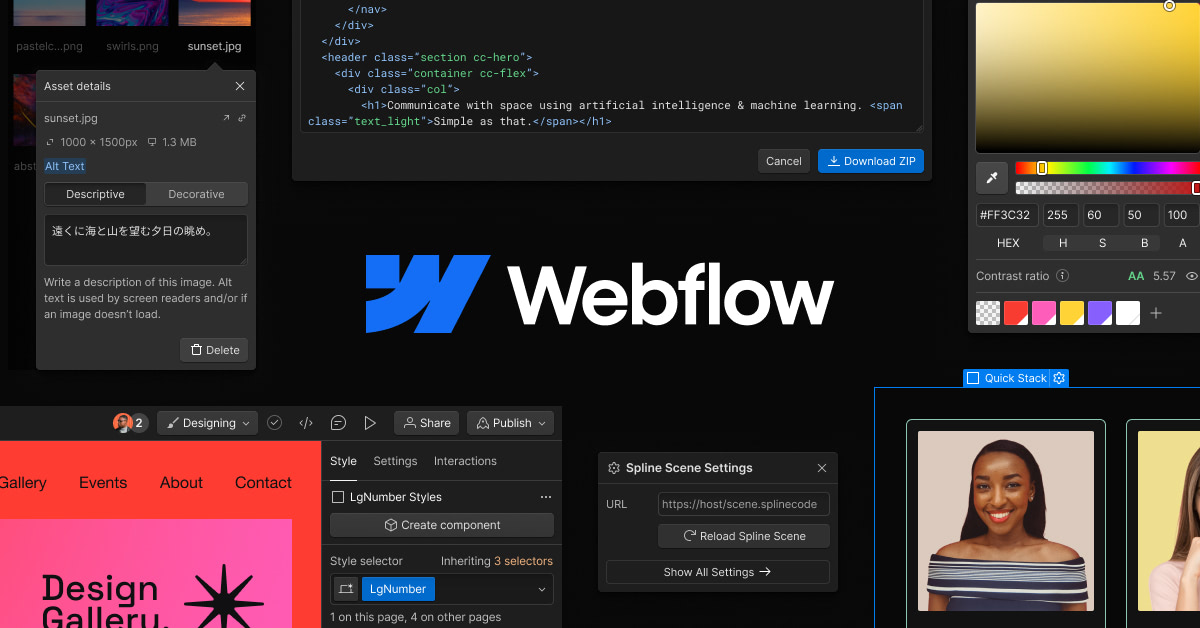The Ultimate Guide to Webflow: The Most Advanced Website Builder
- 1 What is Webflow?
- 2 What Sets Webflow Apart from Other Website Builders?
- 2.1 1. Visual Development and Code Generation
- 2.2 2. No Coding Required
- 2.3 3. Responsive Design
- 2.4 4. Built-in CMS
- 2.5 5. Flexibility and Scalability
- 2.6 6. Hosting and Security
- 3 Key Advantages of Webflow
- 3.1 1. Ease of Use
- 3.2 2. Customizability
- 3.3 3. Speed and Performance
- 3.4 4. Collaboration Features
- 3.5 5. E-Commerce Capabilities
- 3.6 6. Integration and Extendibility
- 4 Why Webflow is the Most Beneficial Solution for Web Development
- 4.1 Professional-Grade Design Without Coding
- 4.2 Rapid Prototyping and Deployment
- 4.3 Cost-Effective Solution
- 4.4 Continuous Improvement and Support
- 4.5 Empowering Creativity and Innovation
- 5 Conclusion
In today’s digital age, having a modern, aesthetically pleasing, and intuitive website is crucial for businesses across all industries. A well-designed website not only enhances a company’s professional image but also builds trust among customers. Whether it’s a construction company, a clothing store, or a local artisan selling handcrafted goods, consumers expect a seamless online experience where they can shop, contact the company, or learn about its policies. Webflow has emerged as a leading platform for creating responsive, visually appealing websites. This article delves into Webflow, what differentiates it from other website builders, and its key advantages.
What is Webflow?
Webflow is a powerful, modern platform that allows users to design, build, and manage websites without coding skills. Unlike traditional website development methods that require knowledge of HTML, CSS, and JavaScript, Webflow offers a visual interface where users can drag and drop elements to create their desired layouts. This makes it accessible to professional web developers and individuals with no coding background.
Webflow operates entirely in the cloud, meaning all work is done through a web browser. This eliminates the need for local software installations and ensures that projects are always accessible from any device with an internet connection. Additionally, Webflow includes a built-in content management system (CMS), making it easy to manage and update content on the site.
What Sets Webflow Apart from Other Website Builders?
1. Visual Development and Code Generation
One of the standout features of Webflow is its visual development interface, which allows users to design their websites visually. Webflow automatically generates clean, semantic code in the background as users drag and drop elements.
2. No Coding Required
While other website builders like WordPress and Wix offer no-code options, Webflow provides more advanced design capabilities and greater control over the site’s appearance and functionality. Users can create complex layouts and interactions without writing a single line of code.
3. Responsive Design
Webflow makes creating responsive websites that look great on any device easy. The platform provides tools to customize layouts for different screen sizes, ensuring a seamless user experience across desktops, tablets, and smartphones.
4. Built-in CMS
Webflow’s CMS is another feature that sets it apart. It allows users to create and manage dynamic content, such as blog posts, product listings, and portfolios, without relying on third-party plugins or extensions. The CMS is fully integrated into the design process, making it easy to create custom content structures and templates that adapt to the content.
5. Flexibility and Scalability
Webflow offers a high degree of flexibility and scalability, making it suitable for projects of all sizes. Whether you’re building a simple landing page or a complex e-commerce site, Webflow provides the tools and features needed to bring your vision to life. The platform also supports custom code, allowing developers to extend its functionality and integrate with other systems.
6. Hosting and Security
Webflow includes hosting services with all its plans, ensuring that websites are fast, secure, and always available. The platform uses Amazon Web Services (AWS) for hosting, providing robust performance and reliability. Additionally, Webflow handles security updates and maintenance, freeing users from these technical responsibilities.
Key Advantages of Webflow
1. Ease of Use
Webflow’s intuitive drag-and-drop interface makes it easy for anyone to design a website, regardless of their technical expertise. The platform offers a wide range of pre-designed elements and templates, which can be customized to suit individual needs. This reduces the learning curve and allows users to create professional-looking websites quickly.
2. Customizability
Unlike other website builders that limit customization options, Webflow provides extensive design flexibility. Users can fine-tune every aspect of their site, from typography and colour schemes to layout and interactions. This level of control ensures that websites built with Webflow can be uniquely tailored to reflect a brand’s identity.
3. Speed and Performance
Webflow’s hosting infrastructure ensures that websites load quickly and perform well. Fast loading times are essential for providing a good user experience and improving search engine rankings. Webflow also offers a range of performance optimization features, such as image compression and lazy loading, to further enhance site speed.
4. Collaboration Features
Webflow supports team collaboration, making it an ideal choice for agencies and large projects. Multiple users can work on a project simultaneously, with version control features ensuring that changes are tracked and managed effectively. This collaborative environment streamlines the workflow and enhances productivity.
5. E-Commerce Capabilities
Webflow offers robust e-commerce features, allowing users to create online stores easily. The platform supports product management, payment processing, and order fulfilment, providing a comprehensive solution for businesses looking to sell products online. Webflow’s e-commerce capabilities are fully integrated into the design process, ensuring a seamless shopping experience for customers.
6. Integration and Extendibility
Webflow integrates with various third-party tools and services, enhancing its functionality and allowing users to build more complex websites. Popular integrations include Google Analytics, Mailchimp, and Zapier. Additionally, Webflow’s API enables developers to create custom integrations and automate workflows.
Why Webflow is the Most Beneficial Solution for Web Development
Professional-Grade Design Without Coding
Webflow empowers users to create professional-grade websites without needing to write code. For businesses, this means they can achieve high-quality, custom designs without the expense of hiring a developer. With Webflow and Webflow experts, you can create applications, online stores and responsive, modern and robust websites.
Rapid Prototyping and Deployment
The ability to quickly prototype and deploy websites is a significant advantage of Webflow. Users can create and test design concepts in real-time, making adjustments. Once a design is finalized, it can be published immediately. This speed and agility are precious in fast-paced industries where time-to-market is critical.
Cost-Effective Solution
By eliminating the need for custom coding and third-party plugins, Webflow offers a cost-effective solution for web development. Businesses can save on development costs and reduce ongoing maintenance expenses. Webflow’s all-in-one platform simplifies budgeting, as hosting, security, and CMS features are included in a single package.
Continuous Improvement and Support
Webflow is continuously evolving, with regular updates and new features being added. The platform’s development team actively listens to user feedback and implements improvements based on user needs. Additionally, Webflow offers comprehensive support resources, including documentation, tutorials, and a dedicated support team, ensuring users have the help they need to succeed.
Empowering Creativity and Innovation
Webflow’s flexibility and range of design tools empower users to push the boundaries of web design. Whether creating interactive animations, unique layouts, or dynamic content structures, Webflow provides the tools to turn creative ideas into reality. This fosters innovation and allows businesses to differentiate themselves in a crowded online marketplace.
Conclusion
In conclusion, Webflow is a modern, advanced platform that offers a unique and powerful solution for web development. Its visual development interface, ease of use, flexibility, and robust features set it apart from other website builders. Whether you’re a professional developer or a business owner with no coding experience, Webflow provides the tools and capabilities to create stunning, responsive websites that meet your needs.
By choosing Webflow, you can enjoy the benefits of professional-grade design, rapid prototyping, cost-effective development, and continuous improvement. The platform’s built-in CMS, e-commerce capabilities, and integration options make it a comprehensive solution for various web development projects. Embrace the future of web design with Webflow and unlock the full potential of your online presence.

















